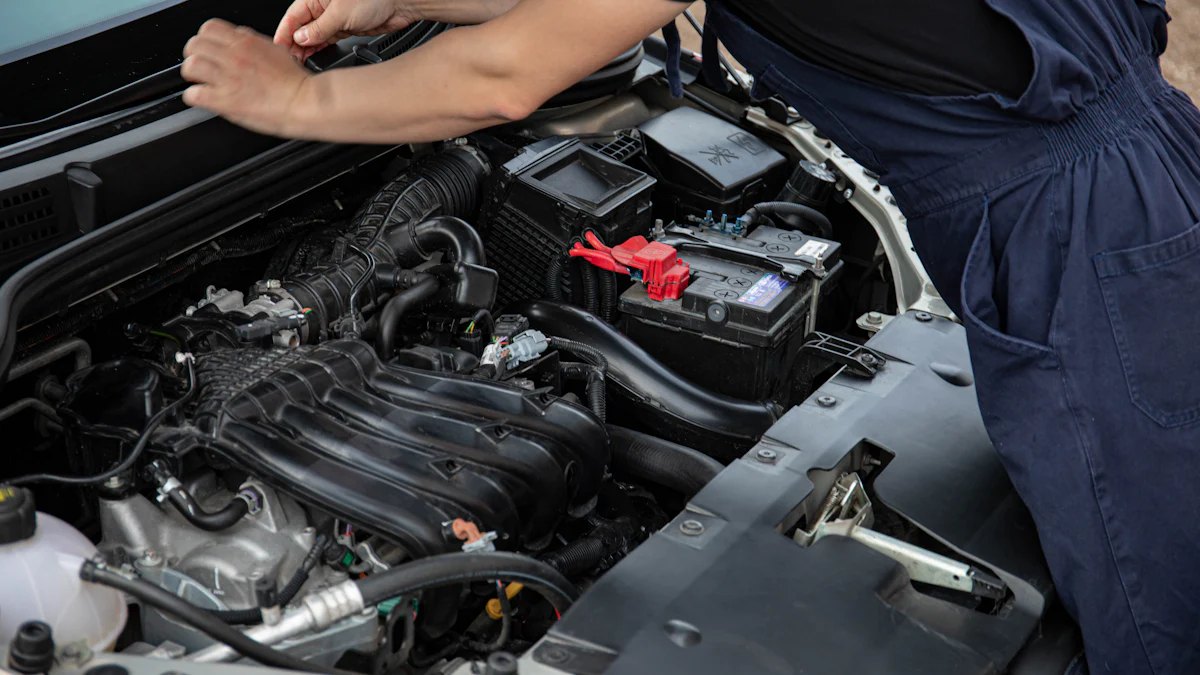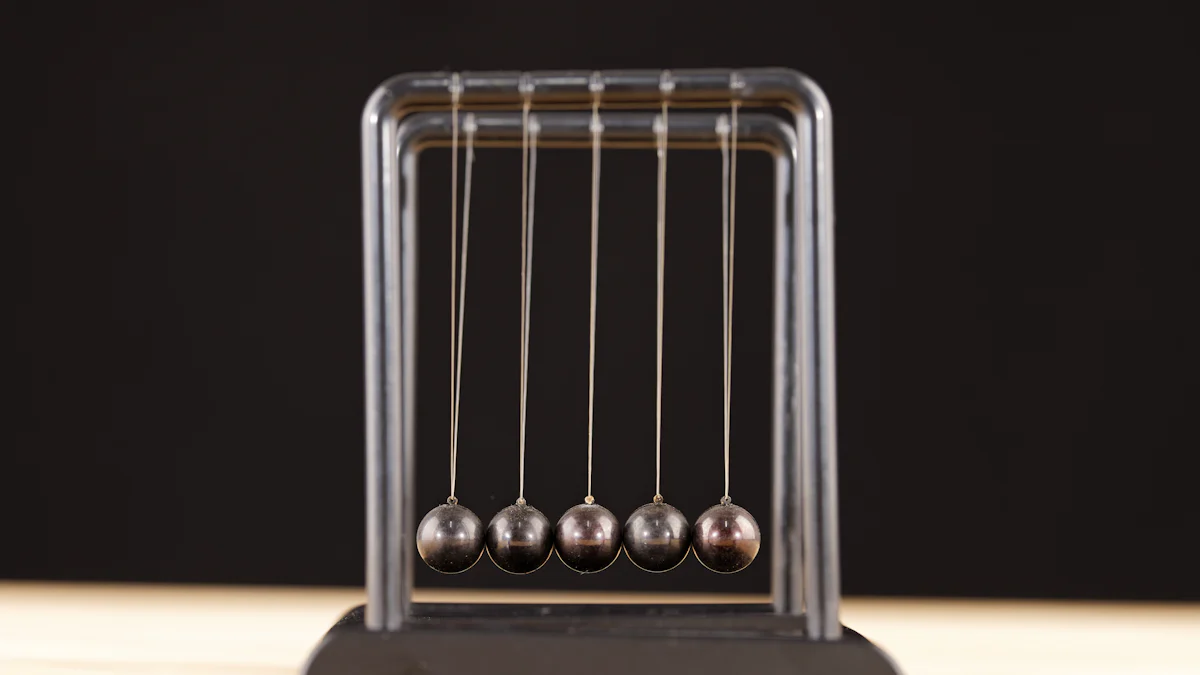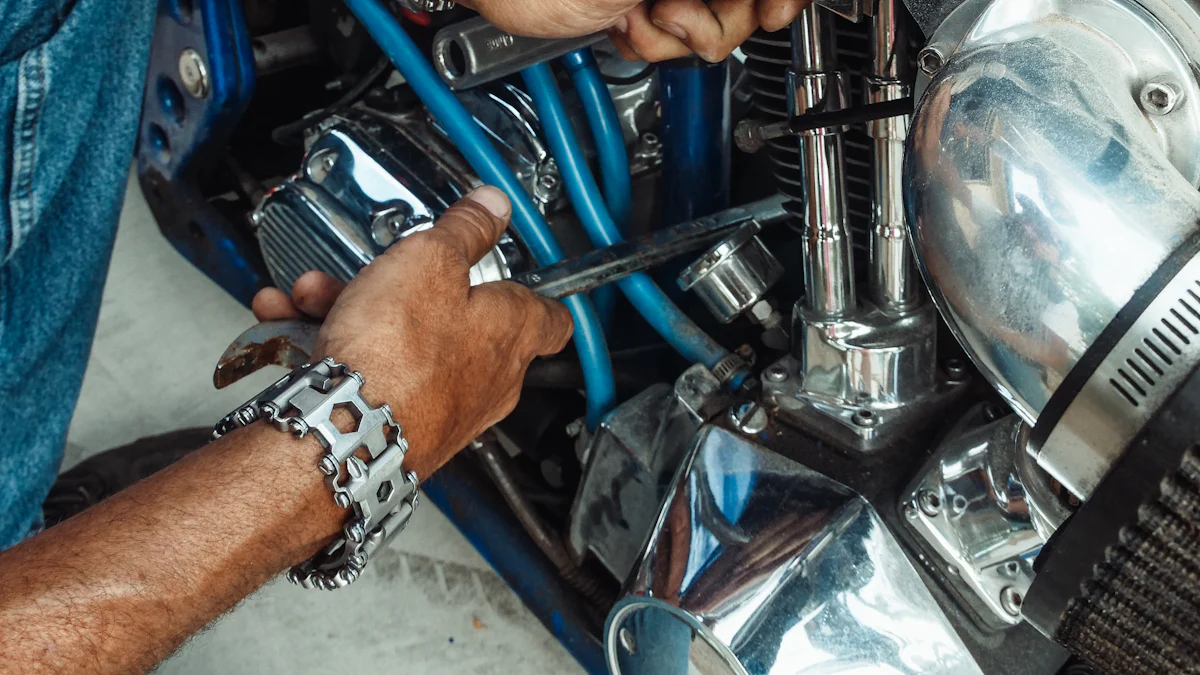
The harmonic balancer is a vital component in vehicle engines, ensuring smooth operation by reducing vibrations. Typically, a 5.3 harmonic balancer puller is used for maintenance tasks related to this crucial part. However, various situations may arise where alternatives are needed to address specific challenges effectively. Understanding the significance of the harmonic balancer and exploring alternative methods can lead to better engine performance and longevity.
What is a Harmonic Balancer?
The harmonic balancer, also known as a crankshaft damper or vibration damper, is an essential component in vehicle engines. Its primary function is to reduce vibrations and ensure the smooth operation of the engine. By absorbing and minimizing the torsional vibrations generated during the combustion process, the harmonic balancer plays a crucial role in maintaining engine stability and longevity.
Definition and Function
Importance in Engine Performance
Automotive Engineers emphasize that the harmonic balancer is specifically designed to facilitate a smoother idle and absorb harmonic engine vibrations as engine speeds rise. This critical function not only enhances driving comfort but also protects various engine components from excessive wear and tear.
Common Issues and Failures
According to Engine Builders, when building a race motor, factors like targeted RPM (Revolutions Per Minute) and BHP (Brake Horsepower) must be considered. An increase in gas pressure in the combustion chamber leads to higher twisting forces on the crankshaft throws, resulting in torsional vibrations. The peaks of this motion, known as amplitude, can cause stress on the engine components if not properly controlled by a high-quality harmonic balancer.
Harmonic Balancer Pulley
Role in Reducing Vibration
Automotive Engineers highlight that the harmonic balancer serves multiple functions beyond vibration reduction. It helps balance the engine by offsetting weights that provide equilibrium to internal parts like the crankshaft. Additionally, it acts as a precise vibration damper, ensuring optimal performance under varying conditions.
Maintenance Tips
Torsional vibration, defined as the end-to-end twisting and rebounding of the crankshaft due to combustion forces, can significantly impact engine durability. The harmonic balancer pulley plays a vital role in controlling this twist to enhance efficiency and prevent premature wear on critical engine components.
By understanding these aspects of harmonic balancers and their pulleys, vehicle owners can appreciate their significance in maintaining optimal engine performance while prolonging the lifespan of their vehicles.
Why Use Alternatives?
Cost Considerations
Budget-Friendly Options
When considering alternatives to the traditional 5.3 harmonic balancer puller, individuals often explore cost-effective solutions that can deliver efficient results without breaking the bank. Opting for budget-friendly options allows car owners to address harmonic balancer maintenance needs without incurring substantial expenses. Here are some practical and economical choices to consider:
- DIY Long Bolts Method: Utilizing long bolts and a hammer can serve as a cost-effective alternative to a specialized puller tool. This approach involves threading long bolts into the balancer’s holes and gently tapping them with a hammer to dislodge the balancer evenly.
- Homemade Tools: Crafting simple tools from readily available materials can be a wallet-friendly way to remove a harmonic balancer. By repurposing items like scrap metal or sturdy rods, car enthusiasts can fashion custom tools tailored to their specific requirements.
- Renting Equipment: Renting specialized tools from local auto parts stores or equipment rental shops presents an affordable option for occasional use. Renting allows individuals to access high-quality tools without the upfront investment associated with purchasing them outright.
By exploring these budget-friendly alternatives, vehicle owners can effectively address harmonic balancer maintenance tasks while keeping costs manageable.
Accessibility and Convenience
Situations Without a Puller
In scenarios where a dedicated harmonic balancer puller is unavailable or impractical, it becomes essential to rely on alternative methods that offer accessibility and convenience. Whether due to time constraints, tool availability issues, or unexpected breakdowns, having backup solutions at hand can be invaluable for addressing urgent maintenance needs efficiently. Here are some accessible and convenient alternatives worth considering:
- Improvised Techniques: In the absence of a conventional puller tool, improvisation using everyday tools like screwdrivers, pry bars, or even sturdy wooden blocks can help dislodge a stubborn harmonic balancer with minimal effort.
- Collaborative Assistance: Seeking assistance from fellow car enthusiasts or professionals in the automotive community can provide access to shared resources and expertise when dealing with challenging maintenance tasks. Collaborating with others can lead to innovative solutions and valuable insights.
- Emergency Roadside Strategies: When faced with harmonic balancer issues on the road or in remote locations, quick fixes using basic tools carried in the vehicle’s emergency kit can temporarily resolve problems until professional assistance is available.
By embracing accessible and convenient alternatives in situations where traditional methods are not feasible, car owners can ensure prompt resolution of harmonic balancer-related issues while minimizing downtime and inconvenience.
Silverado Specifics
Common Problems in Silverado Models
For Silverado truck owners facing harmonic balancer challenges specific to their vehicle models, understanding common issues and targeted solutions is crucial for effective maintenance practices. Some prevalent problems encountered in Silverado models related to harmonic balancers include:
- Belt Alignment Concerns: Misaligned belts caused by worn-out or faulty harmonic balancers can lead to decreased engine performance and potential belt slippage.
- Vibration Dampening Issues: Inadequate vibration dampening capabilities of aging harmonic balancers may result in increased engine vibrations and discomfort during driving.
- Installation Complications: Complex installation procedures for certain Silverado models may require specialized tools or techniques beyond standard removal processes.
By recognizing these model-specific challenges and implementing appropriate solutions tailored to Silverado vehicles, truck owners can ensure optimal performance and longevity of their engines while minimizing potential risks associated with harmonic balancer malfunctions.
5.3 Harmonic Balancer Puller Alternatives
Using Long Bolts and a Hammer
To remove a harmonic balancer without a specialized puller, one effective method involves utilizing long bolts and a hammer. This approach allows the balancer to be dislodged from the engine evenly, ensuring a smooth removal process without causing damage.
Step-by-Step Guide
- Prepare the Tools: Gather long bolts that fit into the balancer’s holes securely and ensure you have a hammer on hand.
- Thread the Bolts: Carefully thread the long bolts into the designated holes on the harmonic balancer, making sure they are evenly inserted.
- Even Tapping: With caution, tap each bolt gently with a hammer in a consistent and uniform manner around the balancer to dislodge it gradually.
- Monitor Progress: Periodically check the alignment and balance of the balancer as you tap to ensure it is coming off evenly.
- Remove Balancer: Once dislodged, carefully remove the harmonic balancer from the engine without causing any additional strain or damage.
Tips for Effectiveness
- Even Pressure: Apply equal pressure when tapping each bolt with the hammer to prevent uneven force distribution.
- Patience is Key: Take your time during this process to avoid rushing and potentially damaging components.
- Inspect Thoroughly: After removing the harmonic balancer, inspect it closely for any signs of wear or damage that may require further attention.
SP Tools 64900
For those seeking an alternative tool to assist in removing an LS3 harmonic balancer or vibration damper, the SP Tools 64900 offers a reliable solution with its unique features and benefits.
Features and Benefits
- Precision Design: The SP Tools 64900 is meticulously crafted to provide optimal performance when dealing with harmonic balancers.
- Durable Construction: Made from high-quality materials, this tool ensures longevity and durability for repeated use.
- Efficient Operation: The design of this tool streamlines the removal process, making it efficient and user-friendly.
- Compatibility: The SP Tools 64900 is compatible with various vehicle models, including those equipped with 5.3 harmonic balancers.
Usage Instructions
- Secure Placement: Position the SP Tools 64900 securely against the harmonic balancer for stability during removal.
- Apply Pressure: With controlled force, engage the tool against the balancer to initiate loosening without causing damage.
- Rotate Safely: Slowly rotate the tool as needed to dislodge the harmonic balancer smoothly from its position.
- Check Alignment: Ensure proper alignment between the tool and balancer throughout the removal process for optimal results.
Starter Ring Tool
Another practical alternative for removing crankshaft pulleys without a puller is using a starter ring tool designed specifically for this purpose.
How to Use
- Place the starter ring tool securely against *the flywheel or flex plate* teeth to prevent crankshaft movement during pulley removal.
- Engage the starter ring tool by applying gentle pressure against the flywheel or flex plate teeth while working on pulley extraction.
Advantages
- Prevents Crankshaft Movement: By securing the starter ring tool properly, it effectively immobilizes the crankshaft, allowing for safe pulley removal.
- Simplifies Maintenance Tasks: Using the starter ring tool streamlines pulley removal processes by providing stability and control over crankshaft movements.
Joyride Episode Insights
Practical Tips from Experts
In the realm of automotive maintenance, experts from various backgrounds often share valuable insights and practical tips to address common challenges faced by car owners. When it comes to dealing with harmonic balancer issues and exploring alternative removal methods, the Joyride Episode offers a treasure trove of knowledge for enthusiasts seeking effective solutions.
- Expert Guidance: Seasoned mechanics featured on the Joyride Episode emphasize the importance of precision and patience when tackling harmonic balancer maintenance tasks. Their hands-on approach and detailed explanations provide clarity for DIY enthusiasts looking to navigate the removal process without specialized tools.
- Tool Recommendations: The experts on the Joyride Episode frequently discuss innovative tools and techniques that can simplify harmonic balancer removal. From homemade solutions to professional-grade equipment, their recommendations cater to a wide range of skill levels and budget considerations.
- Safety Protocols: Ensuring safety during maintenance procedures is a top priority highlighted in every Joyride Episode segment. By following expert advice on securing work areas, using protective gear, and adhering to best practices, viewers can minimize risks associated with harmonic balancer maintenance.
- Troubleshooting Tips: In-depth discussions on troubleshooting common issues related to harmonic balancers offer viewers valuable insights into diagnosing problems effectively. By learning how to identify warning signs early on, car owners can proactively address potential issues before they escalate.
User Experiences
Drawing from real-world experiences shared by users who have implemented alternative methods for removing harmonic balancers, a diverse range of perspectives emerges. These user experiences shed light on the practicality, effectiveness, and challenges associated with utilizing unconventional approaches in harmonic balancer maintenance.
- DIY Success Stories: Enthusiastic DIYers recount their successful attempts at using long bolts and hammers to remove harmonic balancers without traditional puller tools. Their detailed accounts provide step-by-step guidance for novices interested in trying out this cost-effective method.
- Unexpected Hurdles: Some users candidly share challenges they encountered while employing alternative removal techniques. From alignment issues to unexpected resistance during dislodging, these firsthand narratives offer valuable lessons on troubleshooting and adapting strategies mid-process.
- Lessons Learned: Through shared user experiences, valuable lessons emerge regarding the importance of preparation, patience, and adaptability when opting for non-conventional methods. Users reflect on what worked well, what could be improved, and how they plan to approach similar tasks in the future.
Pros and Cons
Exploring the pros and cons of long bolts and hammer methods alongside other alternative approaches provides a comprehensive view of their efficacy in harmonic balancer maintenance. By weighing the advantages against potential drawbacks, car owners can make informed decisions based on their specific needs and circumstances.
Pros:
- Cost-Efficiency: Utilizing long bolts and hammers as an alternative method proves highly cost-effective compared to purchasing specialized puller tools.
- Accessibility: The simplicity of this approach makes it accessible to DIY enthusiasts with basic tools readily available in most home garages.
- Versatility: The versatility of long bolts allows for customization based on individual requirements or unique engine configurations.
- Minimal Damage Risk: When executed carefully following proper guidelines, the long bolts method minimizes the risk of damage to delicate engine components during removal.
- Learning Opportunity: Engaging in DIY maintenance using unconventional techniques fosters a deeper understanding of engine mechanics and enhances practical skills over time.
Cons:
- Precision Challenges: Achieving even dislodgement without causing misalignment or damage requires meticulous attention throughout the process.
- Time-Intensive: Compared to using specialized puller tools that expedite removal procedures, the long bolts method may require more time investment.
- Skill Requirement: While beginner-friendly in essence, mastering this technique demands practice and familiarity with engine components’ intricacies.
- Limited Application: Certain engine models or configurations may pose challenges when applying this method due to space constraints or structural variations.
- Potential Risks: Inexperienced users run the risk of improper execution leading to unintended consequences such as stripped threads or distorted bolt heads.
Recalling the pivotal role of the harmonic balancer in engine performance, it becomes evident that maintaining this component is essential for smooth operation and longevity. Exploring diverse alternatives like the DIY Long Bolts Method and innovative tools such as the SP Tools 64900 offers practical solutions for harmonic balancer maintenance. To ensure optimal performance, regular inspection and timely repairs are recommended. By adopting cost-effective approaches and leveraging specialized tools when needed, vehicle owners can safeguard their engines against potential issues and enjoy uninterrupted driving experiences.
Post time: May-28-2024





